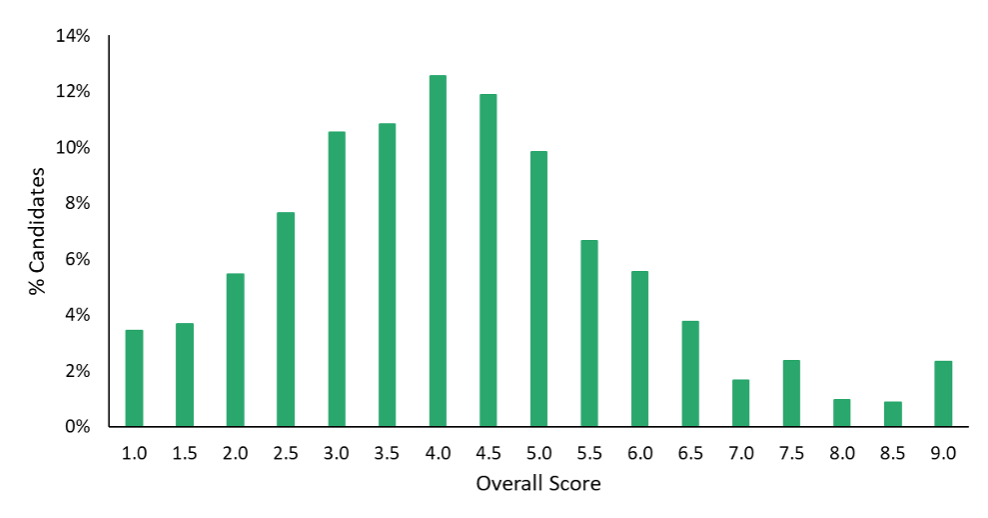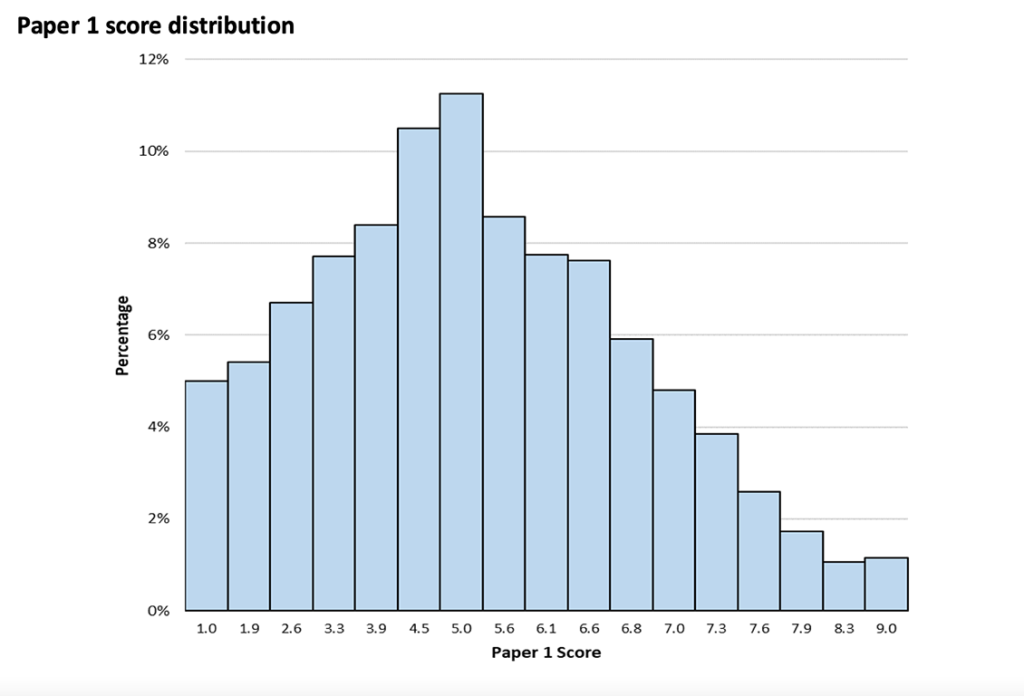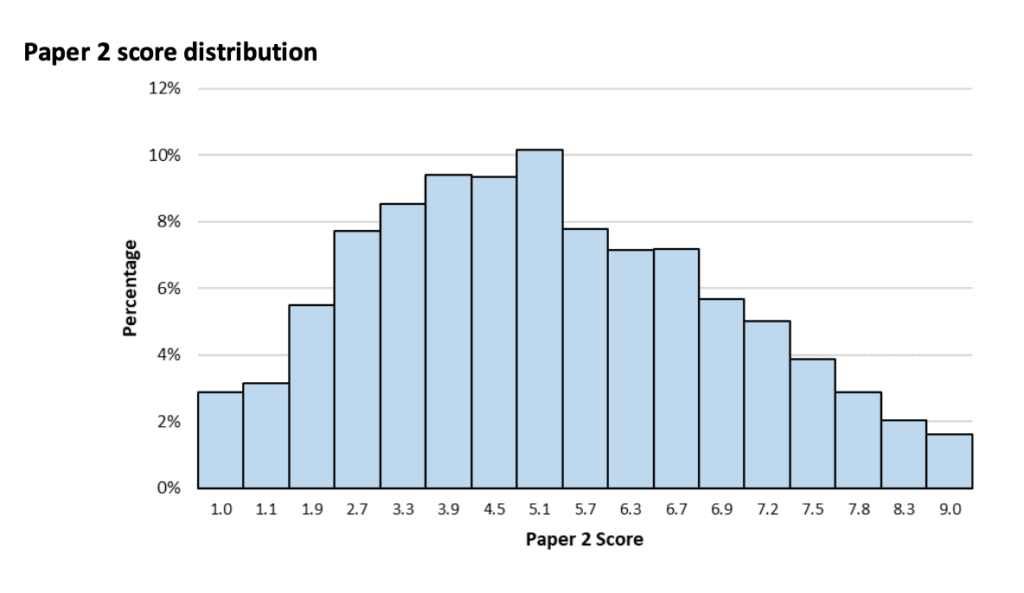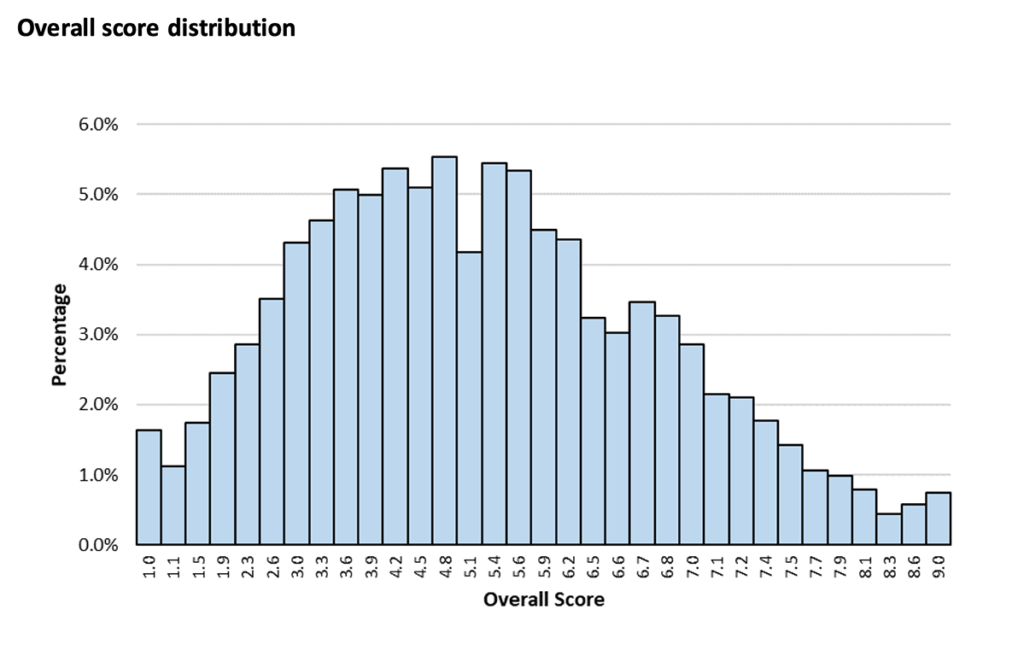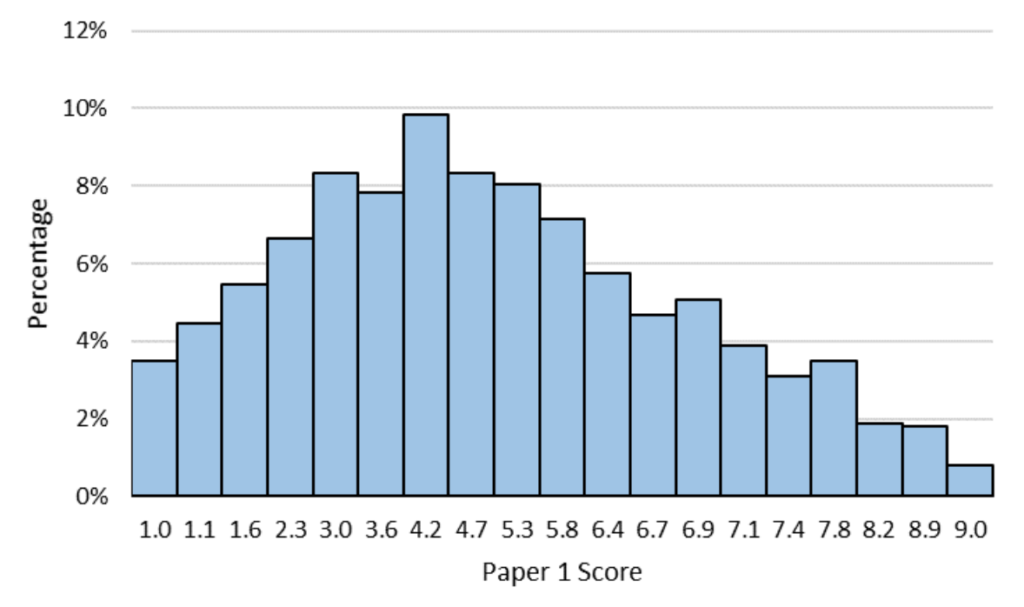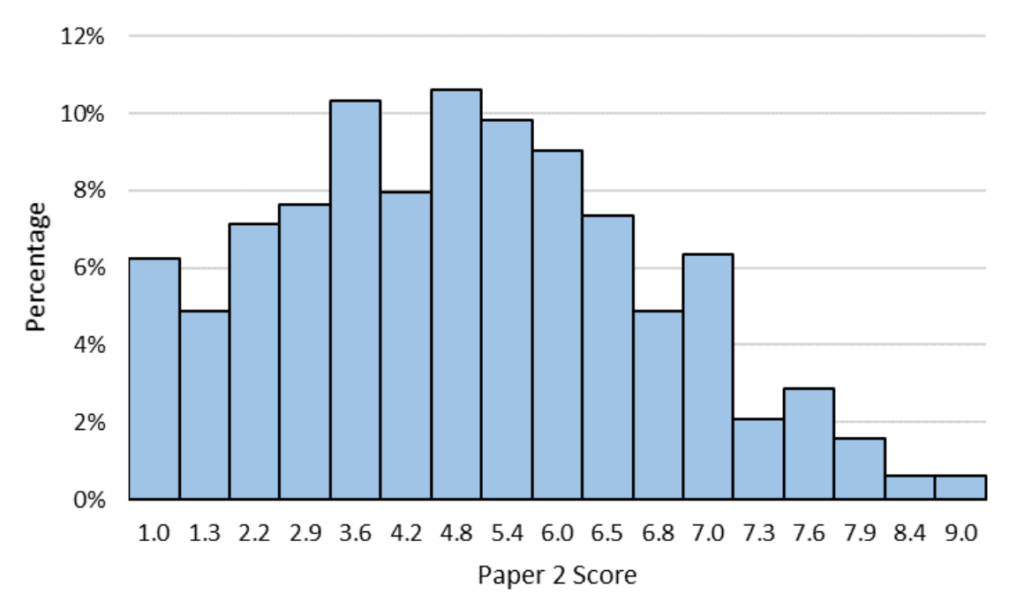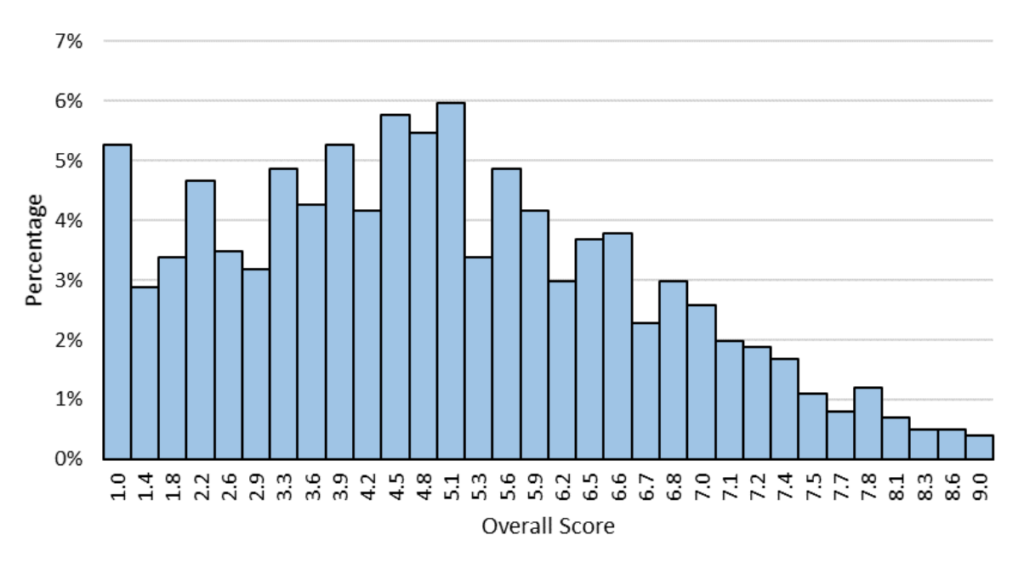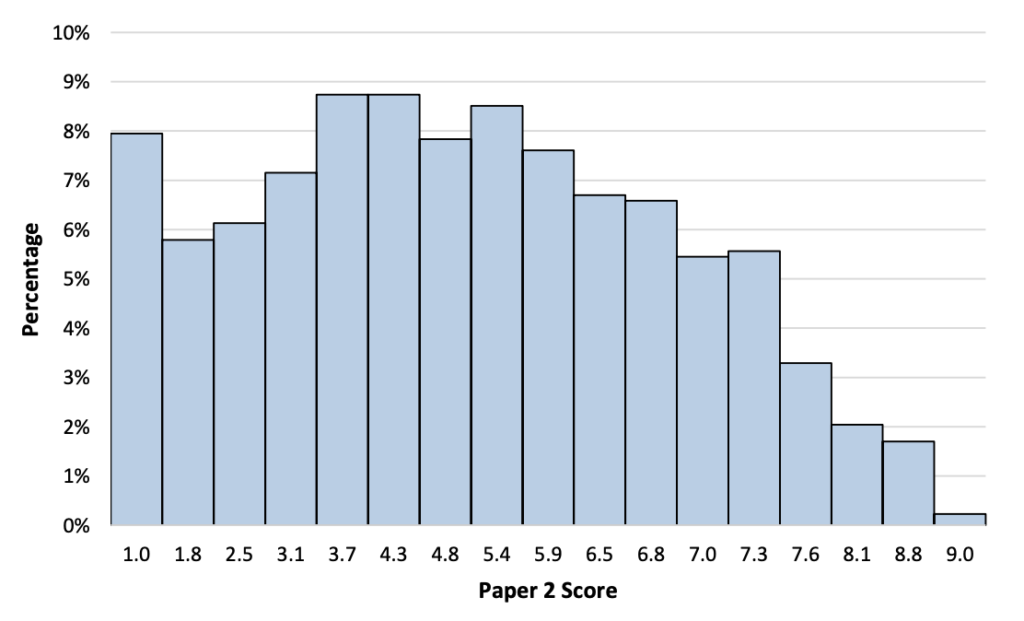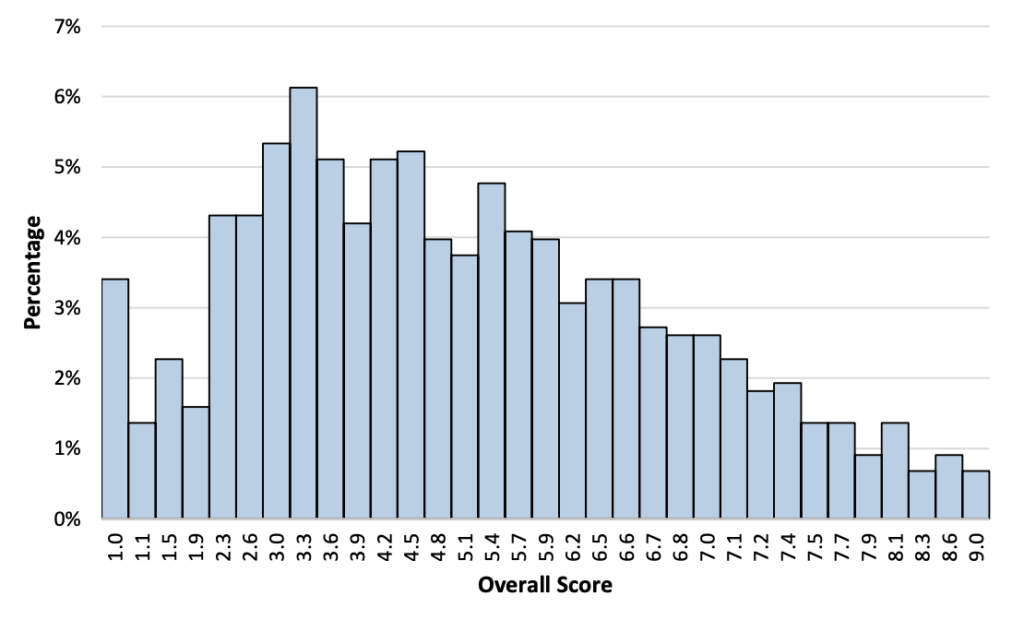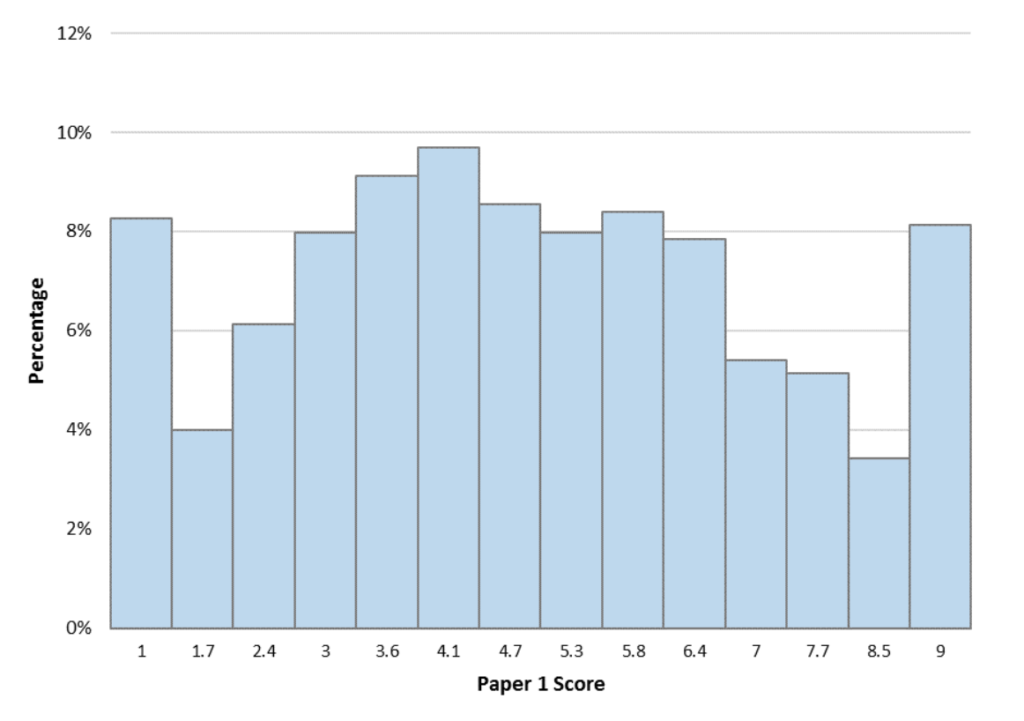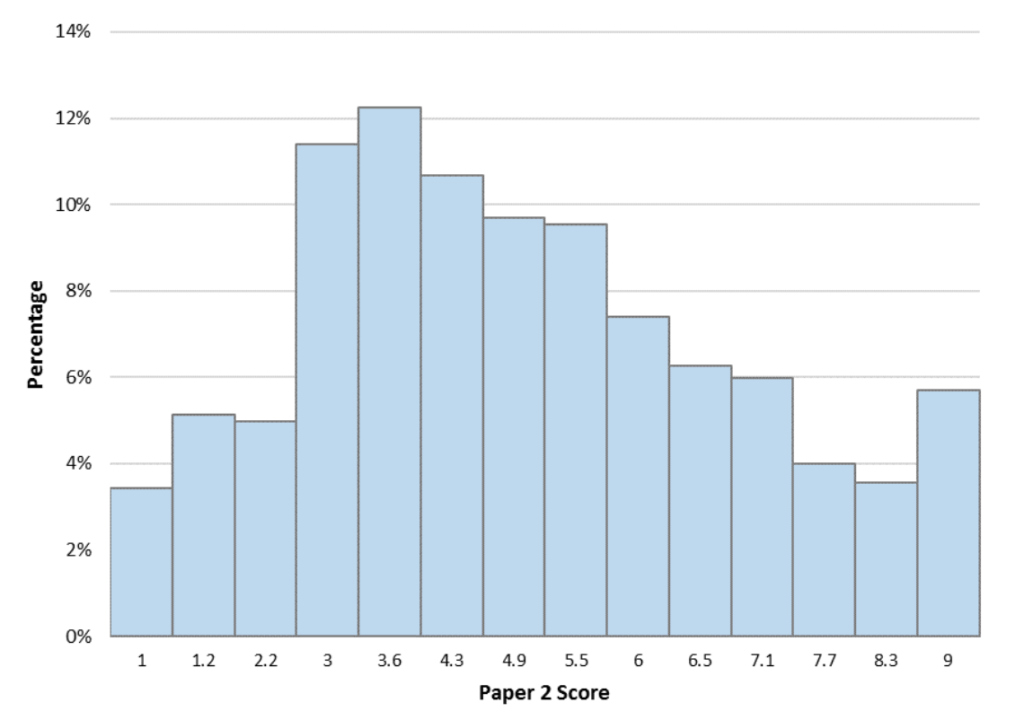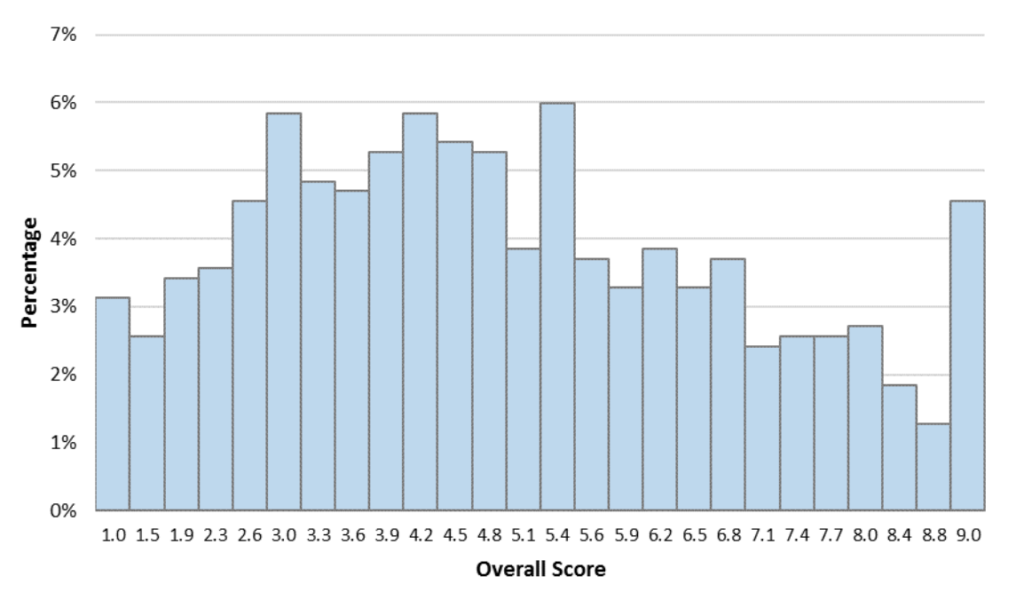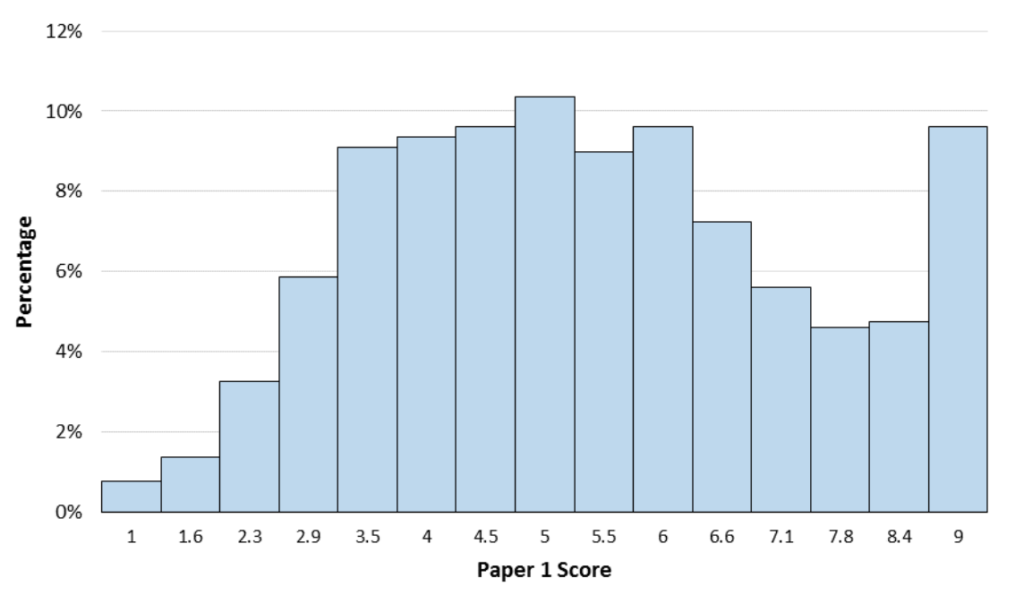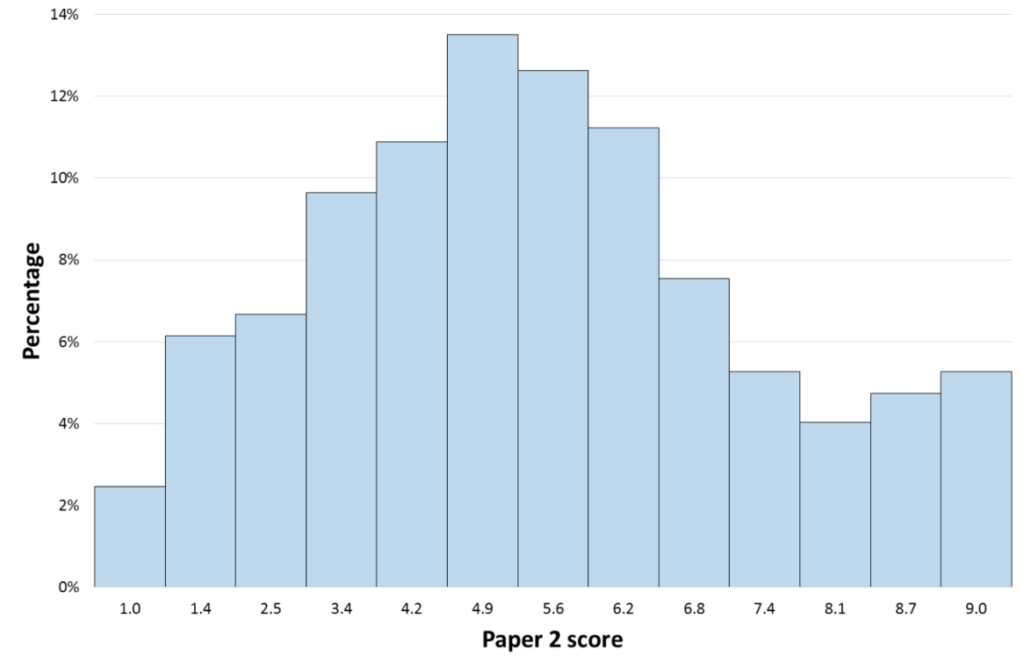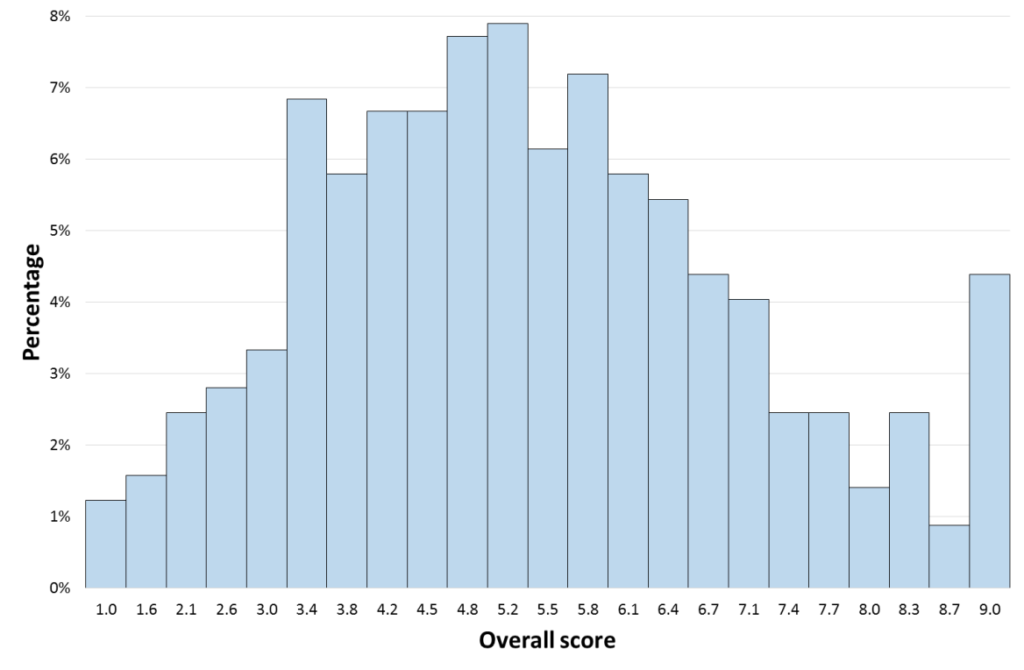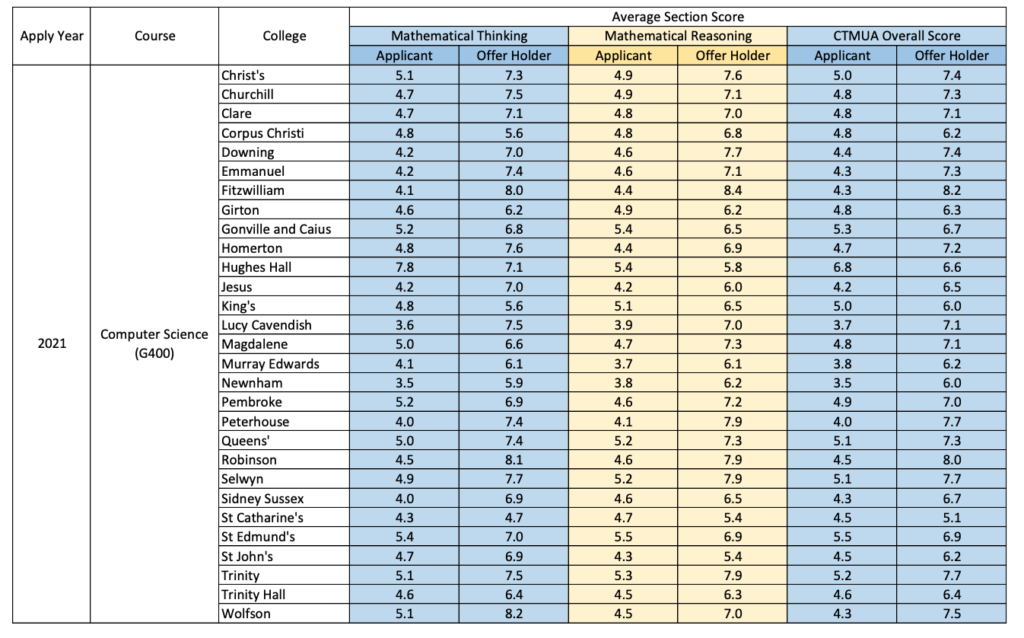YOUR ULTIMATE GUIDE
TMUA Results - The Definitive Guide to your TMUA Score
Written by: Matt Amalfitano-Stroud
The TMUA is a tough exam, so getting a good result is difficult. But to have the best chance of getting a high score, it’s good to know more about the scoring system itself. How is the final score calculated, what do universities do with your score and what do previous years’ results look like? This guide will answer all of these questions and more!
1/4
HOW IS THE TMUA SCORED?
Let’s start with the basics; how is the TMUA marked and what does your final TMUA Score mean?


The Test of Mathematical for University Admission (TMUA) is brought to us by Pearson VUE, which is responsible for many of the UK’s admissions tests. The TMUA is made up of two sections divided between papers, Paper 1 and Paper 2. Although the question types are different between papers, they each consist of 20 multiple-choice questions that are worth one mark each. Therefore, the marking scheme for each paper is the same, aside for their score conversions.
These score conversions are recorded on the Score Conversion Tables used to determine each applicant’s final TMUA Scores. This final score is a value placed upon a scale between 1.0 and 9.0, based on how many marks you achieved. There are three separate conversion tables each year; one for each paper and an overall score based on the marks from both papers out of 40. This means that you will also receive three separate scores, although the combined score is the one considered the most serious.
Here are the conversion tables from the last two years of the TMUA:
TMUA Score Conversion Table 2023 Entry
Paper 1
| Raw Mark | Converted Score |
|---|---|
| 0 | 1.0 |
| 1 | 1.0 |
| 2 | 1.0 |
| 3 | 1.2 |
| 4 | 2.2 |
| 5 | 3.0 |
| 6 | 3.7 |
| 7 | 4.4 |
| 8 | 5.0 |
| 9 | 5.6 |
| 10 | 6.1 |
| 11 | 6.5 |
| 12 | 6.7 |
| 13 | 7.0 |
| 14 | 7.2 |
| 15 | 7.4 |
| 16 | 7.7 |
| 17 | 8.0 |
| 18 | 8.4 |
| 19 | 9.0 |
| 20 | 9.0 |
Paper 2
[table “” not found /]
Overall Score
| Raw Mark | Converted Score |
|---|---|
| 0 | 1.0 |
| 1 | 1.0 |
| 2 | 1.0 |
| 3 | 1.0 |
| 4 | 1.0 |
| 5 | 1.0 |
| 6 | 1.5 |
| 7 | 1.9 |
| 8 | 2.4 |
| 9 | 2.8 |
| 10 | 3.2 |
| 11 | 3.5 |
| 12 | 3.9 |
| 13 | 4.2 |
| 14 | 4.5 |
| 15 | 4.8 |
| 16 | 4.1 |
| 17 | 5.4 |
| 18 | 5.7 |
| 19 | 6.0 |
| 20 | 6.2 |
| 21 | 6.5 |
| 22 | 6.6 |
| 23 | 6.7 |
| 24 | 6.8 |
| 25 | 6.9 |
| 26 | 7.0 |
| 27 | 7.1 |
| 28 | 7.2 |
| 29 | 7.3 |
| 30 | 7.4 |
| 31 | 7.6 |
| 32 | 7.7 |
| 33 | 7.8 |
| 34 | 8.0 |
| 35 | 8.2 |
| 36 | 8.4 |
| 37 | 8.6 |
| 38 | 9.0 |
| 39 | 9.0 |
| 40 | 9.0 |
The values between the different tables in each year are meant to be representative of the difficulty of each paper. For example, if Paper 2 was considered to be noticeably more difficult than Paper 1, the conversion table would reflect this by requiring a lower mark to achieve a similar TMUA Score. As you can see though, many of the values between papers (and even between different years) are similar or identical, meaning the difficulty is generally very balanced throughout. The differences that do appear are never very extreme, so they won’t have a major effect on your result or how you take the test.
TMUA Results 2024/25
Below is the score distribution chart for the October 2024 and January 2025 sitting of the TMUA. This was the first sitting held under UAT-UK and Pearson VUE, so the results have been reported differently from previously.
The results for each paper have not been published individually, so we can only see the overall results of the cohort. However, what we can see is that most applicants scored 4.0. A score within the range of 3.0 – 5.0 was fairly common, while very few applicants achieved a score of 7.0 or higher.
If you’re due to sit the TMUA, you should aim to score in this top range to have the best chance of getting your interview/offer.
When Do TMUA Results Come Out?
Results for the TMUA are released roughly 6 weeks after the testing period. This means that results will be released in late November for those sitting the October sitting and mid-February for the January sitting.
The University of Cambridge and Imperial College London will both automatically be sent your results beforehand, as the TMUA is a requirement for various courses at both universities.
Prepare for TMUA success with TMUA.Ninja
With the TMUA.Ninja Preparation Platform, you’re getting the most effective way to perfect your skills in time for the test. Sign up today for free to begin your TMUA preparation journey!
2/4
HOW DO UNIVERSITIES USE YOUR RESULTS?
Not every university uses your results in the same way, so let’s take a look at each of the universities that accept the TMUA to see what your results will mean to them!
Each university will have its own process for using the TMUA results in the admissions process but all of them will boil down to using the results alongside the other aspects of your application to determine if you should be accepted or not. Also note that the TMUA is not compulsory for all of these universities, meaning you could decide not to sit the test for whatever reason. However, submitting a TMUA result will give your application the boost it may need to stand out from the crowd, so it is definitely worth taking. Let’s take a look at each university and see how they will use your TMUA results:
University of Cambridge
As previous stated, Cambridge will automatically receive your TMUA score, meaning you won’t need to go through the process listed above. No specific details are provided regarding how the results are used by the admissions team, though it is likely that they are used alongside other aspects of your application to shortlist candidates for interview and again when making the final decision.
Durham University
Durham has created an upper threshold for TMUA which grants applicants eligibility for reduced offers. The system works as follows:
– Applicants who score above 6.5 will be eligible for an offer that requires reduced final grades (requiring A*AA instead of A*A*A).
– Applicants who score between 4.5 and 6.5 will still be under consideration for a standard offer, with their TMUA score acting as positive evidence of ability in mathematics.
– Applicants who score below the threshold of 4.5 may still be considered but will be less likely to receive an offer. This threshold is subject to change slightly each year but 4.5 is the baseline.
Bear in mind that Durham also accepts the STEP to support your application.
Imperial College London
For the first time, in 2024, Imperial College London will be using the TMUA to test applicants for Economics, Computing and Joint Mathematics & Computer Science courses. All applicants will be required to sit the test, so we can assume the scores will be considered fairly heavily during the decision-making process, seeing as Imperial does not interview all applicants.
London School of Economics and Politics (LSE)
The TMUA is only mandatory for two courses at LSE – Economics and Econometrics & Mathematical Economics – but is considered for various other degrees at the university. However, no specific details are provided into how the TMUA is considered by the university’s admissions team.
University of Warwick
Once again, Warwick will accept from the TMUA, and STEP for your application, with multiple degrees requiring the TMUA to be completed (Computer Science, Economics, Discrete Mathematics and more). It is said that threshold scores are set of entry, but these are calculated once all results have been submitted.
So the main takeaway from this is that it will be a huge benefit to your application to take the TMUA and, in many cases, will be essential to be considered. Whether it’s due to the additional positive evidence of ability or the chance to receive a reduced offer, submitting a good TMUA result is definitely worth the time and effort it will take. But that does open up the question “What is a good TMUA Score?”
What Is a Good TMUA Score?
This question is actually pretty simple to answer. Several of the TMUA universities have specified that a score of 6.5 would be considered high and would provide the applicant with benefits to their application. Although Lancaster University is a bit more generous, offering these benefits to those with scores of 4.5, it seems to be agreed upon by most of these unis that 6.5 is the point at which your TMUA score will have a very positive effect on your application.
It’s important to specify that a score just below this wouldn’t be considered bad. When looking at the Historical Results listed below, we can see that achieving more than 6.0 in the TMUA was less common, with most applicants falling around that 4.0 – 5.5 mark. A score in that range would typically be considered average to decent and thus would still act as positive evidence of mathematical ability. The unis know this is a tough exam, which is why those who are able to do exceptionally well in it are rewarded, while those with average scores are still considered relatively impressive.
What If I Get a Bad TMUA Score?
With all that being said, there are still scores that are not at all desirable for the TMUA, specifically anything below 4.0 or so. Scores within the 3.0 range are still fairly common, but unfortunately, would not reflect too positively on your application. Remember though, the option will be available to not submit your results for most universities. This is only recommended in very extreme cases, but it could potentially save you from having to show the admissions teams very poor results. Again though, this is something that should only be considered for scores at the very bottom of the scale.
Exams.Ninja Tip
If you have performed this badly and do not want to submit your score, it is recommended that you sit the STEP instead, which takes place in June. This will give you another chance to get a good score on an entrance exam that can be used to improve your application. If you are confident that your application is strong enough without an admissions test result, you have the option to not provide one, but it’s important to understand the potential benefits you’ll be missing out on by not submitting a result.
Can I Resit the TMUA?
No, the TMUA can only be taken once per admissions cycle. As stated above, you have the option to either sit the STEP or not submit any result if you do not wish to share your TMUA result (this is not applicable for Cambridge though).
Remember though, the option will be available to not submit your results for most universities. This is only recommended in very extreme cases, but it could potentially save you from having to show the admissions teams very poor results. Again though, this is something that should only be considered for scores at the very bottom of the scale.
3/4
HISTORIC TMUA RESULTS
We now know what the universities are looking for, but how did applicants from previous years do in the test? Let’s find out what the results were like in previous papers!
Although the TMUA is used by multiple universities, the results for all applicants are recorded together as the test is marked by University Admissions Testing (UAT) not the university. Each year, they will publish an “Explanation of Results” for the year’s test. These documents present the score distributions across all test-takers in a bar graph, recording the percentage of applicants for each score and providing some written context to the data. We have all of these documents available to download alongside all the TMUA Past Papers, but let’s take a look at the results for the TMUA sat in 2022 (for 2023 Entry):
TMUA Results - 2023 Entry
The score distribution charts and explanation of results documents are unfortunately not available for the results of the 2023 TMUA. However, we do know the mean scores for each paper of the test:
TMUA Paper 1 Mean Score - 2023
4.8
TMUA Paper 2 Mean Score - 2023
4.9
TMUA Overall Mean Score - 2023
5.1
TMUA Score Distributions - 2022 Entry
While this isn’t an exact calculation, these graphs can give us a rough idea of the average scores throughout the exam. We can see which score was the most common amongst test takers in 2021 (5.0 for Paper 1, 5.1 for Paper 2 and 4.8 overall), as well as being able to see general trends such as where higher scores become less common.
From these results, we can see that a score around 5.0 mark would be pretty average, while scores up to 7.0 were still fairly common but definitely good to get. Though much less common, it seems it wasn’t impossible to achieve an overall score of 9.0, considering nearly 1% of applicants achieved it. Inversely, there were a fair few applicants who only scored 1.0, with nearly 2% in the overall score distribution. While there’s rarely a cut-off score for the TMUA, it’s a safe bet that a score of 1.0 isn’t going to be particularly desirable for admissions teams.
This is just the most recent set of results, however. There are another five years worth of data available for us to view, so let’s see how the score distributions have changed throughout the years:
TMUA Score Distributions - 2021 Entry
TMUA Score Distributions - 2020 Entry
TMUA Score Distributions - 2019 Entry
TMUA Score Distributions - 2018 Entry
TMUA Score Distributions - 2017 Entry
So what can we unpack from this data? Starting from 2021 Entry, we can see that the average scores sit around the same place as the most recent test, although there appear to be fewer applicants scoring 9.0 this year.
In the previous year, we can see the most common scores amongst applicants have fallen, with 3.3 being by far the most common score (just over 6% of applicants). From there, the slope down to 9.0 is still fairly gradual though, meaning a good amount of applicants still scored well.
The next three years all have a major trend in common though; an abnormal amount of applicants scored 9.0 on each test. This is most noticeable for 2018 Entry, where 9.0 was by far the most common overall score with almost 12% of applicants achieving it. This is a sign that the TMUA papers were too easy, as a typical admissions test aims for an average score of around 5.0. The fact that this trend continued for three years also shows that it took a lot of time to properly balance the test from its initial inception.
All of this data gives a pretty accurate look into how each year’s TMUA paper was received by applicants, with the common scores and trends showing whether a year was easy or difficult in comparison to others. By 2022, the test development process was fine-tuned to the point where it would be incredibly unlikely to see results like those seen in the first three years of the exam.
Balancing and testing an admissions exam is a difficult process, and these historic results give us an interesting insight into the things that test developers need to consider when creating questions and score conversion tables.
The last thing that can provide extra context to the previous year’s results is specific data sets. Freedom of Information Requests (FOI) are a means by which the public can request information regarding university admissions processes, as universities are considered public bodies. Through these requests, we can learn some interesting things about how universities use the scores they receive.
As an example, this table shows the TMUA data collected from 2021 Entry applicants of the University of Cambridge, separated by college:
TMUA Cambridge Average Scores - 2021 Entry
Not only does this show us the average calibre of students that applied for Computer Science at Cambridge but it also gives us a macro-view of the admissions standards for each college. We can see that Fitzwilliam College had the highest scoring average accepted with 8.2, while the lowest was St. Catherines with 5.1. If you’re sitting the TMUA for Cambridge, this table will give you an idea of which colleges you should consider based on your confidence and current scores on past papers.
Of course, this level of data is not currently available for every TMUA university or for every year of the test, but researching these figures or making your own FOI Requests to the universities of your choice may help you understand exactly what score you’re going to need to get onto your dream course!
Do you want to boost your TMUA Score?
TMUA.Ninja provides you with everything you need to prepare for the big test, including tutorials, practice questions, worked solutions and past papers. You can get started for free by simply signing up!
4/4
WHAT TO DO AFTER YOU GET YOUR RESULTS
Once the TMUA is finished, your work isn’t over yet. Let’s see what else needs to be done once your TMUA score has been released.
Once you’ve got your results, what happens next? Firstly, as we’ve already discussed, you’re going to need to decide which universities you want to send your results to. The actual process of sending them out is very simple, so the main thing you need to do is actually make the decision. If you’ve got a good score (over 6.5) then the safest thing to do would be to send the results to every option that accepts them. You may not have an interest in attending some of these unis, but it’s still important to get offers from as many places as possible to give yourself options.
Depending on how low your score may be, you might feel unsure about sending it off to some places. Take some time to research how each university uses the results and base your decision on that. You can see that Durham places the least emphasis on the exam and has lower standards for it. It may still be worth sending lower scores there as they may still consider them a positive reflection of your skills. This is an important decision to make so don’t rush it.
Once your results have been submitted, what next? At this point, for most universities, you will just need to wait for their decisions to be released via UCAS or offer letters. That is unless you’ve applied for Cambridge of course. All Cambridge courses require applicants to be shortlisted and invited to interview, which is decided by the admissions team using the personal statements, grades and TMUA results of applicants. If you are invited to interview, you will be informed around mid-November ready for virtual interviews to take place in the first three weeks of December. You will likely have to attend at least two interviews during this process.
Once this process is complete, Cambridge applicants should be informed of their final decision around mid to late January. Other universities will release their decisions much later, as the application deadline for these universities is always at the end of January. As the decisions are made over the next few months, you must begin the process of deciding which offer you wish to accept. You will need to choose two universities, a firm offer and an insurance offer, a decision which cannot be undone once made. All other offers will need to be manually rejected. All of this is done via your UCAS profile, which will house all of your offers.
Once you have made your final decisions, you will then need to work towards achieving your final grades in order to confirm your place on the course. This is a requirement for those with conditional offers, but it is still recommended that applicants with unconditional offers put in the same effort to achieve these grades as well.
One possibility that you must be prepared for is the chance of not getting an offer from the university you wish to attend or receiving no offers at all. If you have not received an offer from your desired university, you will need to choose between attending an option that did give you an offer or reapplying for your primary choice in the next admissions cycle. For those with no offers, only the latter option is available, provided you still wish to attend university. All universities will have the option to appeal the result but this is only reserved for cases with extraordinary circumstances or where evidence of bias or discrimination is present.
When reapplying for university, it’s important to reflect on where things went wrong last time and aim to improve on those things. For example, if your TMUA score wasn’t strong enough to elevate your application, you should aim to be more prepared for it next time. This can be achieved by using a preparation support service such as TMUA.Ninja, which gives you access to tonnes of tutorials, practice questions and past papers. You can try it out for free today by creating an account!
That concludes our look at TMUA scoring and results. The TMUA is unusual for an admissions test in that it’s rarely essential to take for your application. However, you should now understand how much a good TMUA score can benefit you and your chances of getting into your dream university! With all that in mind, why not begin your TMUA practice by learning the basics with our TMUA Starter Guide? Or if you’re ready to get straight into the heavy stuff, you can jump straight into TMUA.Ninja’s collection of practice questions and past papers!
Get everything you need for your TMUA preparation in one amazing package!
With TMUA.Ninja, all of your revision essentials are available in one place. Utilise our three core components to boost your skills and improve your chances of success:
Training Temple – Learn about everything in the TMUA Specification with over 100 expert tutorials about the TMUA, giving you all the subject knowledge and expert exam tips.
Practice Dojo – Take on over 500 practice questions, each with a fully worked solution to help you understand every answer
Exam Arena – Take on 5 full TMUA past papers in our realistic exam simulator. track your progress and see how you will do on the real thing.
Sign up today to maximise your chances of success!

